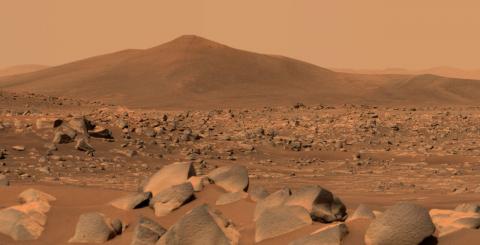Reactions: Mars Express examines large ice sheets beneath Mars equator
Fifteen years ago, the European Space Agency's (ESA) Mars Express probe revealed the presence of large deep deposits on Mars, in an area called the Medusae Fossae Formation (MFF), located at its equator. Now, new data from the probe's MARSIS radar indicate that the deposits are deeper than previously thought - up to 3.7 kilometers thick - and include both ice-rich and dusty layers. The results are published in Geophysical Research Letters.

Map of what appear to be large ice sheets beneath Mars' equator. Credit: Planetary Science Institute/Smithsonian Institution.
César Menor - placas hielo Marte EN
César Menor Salván
Astrobiologist and lecturer of Biochemistry at the University of Alcalá
Although the presence of ice on Mars is not something very new, the presence of an ice mass of this size (the authors conclude that it may be equivalent to between one and a half and three meters of water thickness) and in a location, the Medusae Fossae Formation, which is interesting for future missions, is great news.
This water could be essential for hypothetical future manned missions to Mars but, leaving aside what is still science fiction, the analysis of these ices may yield interesting data about the evolution of the planet (climates, atmospheric compositions), as ices often trap such things as gas bubbles, dust particles, as well as salts and potential organic compounds.
It should be cautioned that the fact that there is an ice-rich formation does not imply anything about potential life on Mars. That is, the fact that there is ice or water does not mean that life originated or that there is life, nor does it imply that there are 'microorganisms' trapped in the ice, as occurs in terrestrial ice masses. Water is a necessary condition for life, but not sufficient.
J Martínez Frías - hielo marte EN
Jesús Martínez Frías
Planetary geologist and astrobiologist at the IGEO (CSIC-UCM). Academician of the Royal Academies of Sciences and Doctors of Spain. President of the Planetary Geology Commission of the Geological Society of Spain and of the Spanish Network of Planetology and Astrobiology.
This is a very interesting and scientifically coherent study, from both the point of view of the geology of Mars and its astrobiological implications.
Methodologically, it is based on solid techniques and data. This research complements previous studies very well.
The existence of surface and subsurface ice on Mars is not new, but this research accurately details new data on MFF materials, emphasising and quantifying the presence of ice layers. Obviously, it would be important to confirm the properties of the ice and the materials with which it is mixed in situ.
The presence of ice is not only important as an element of habitability for the possible existence of micro-organisms, but also as a natural habitability resource for future manned missions.
Thomas R. Watters et al.
- Research article
- Peer reviewed



